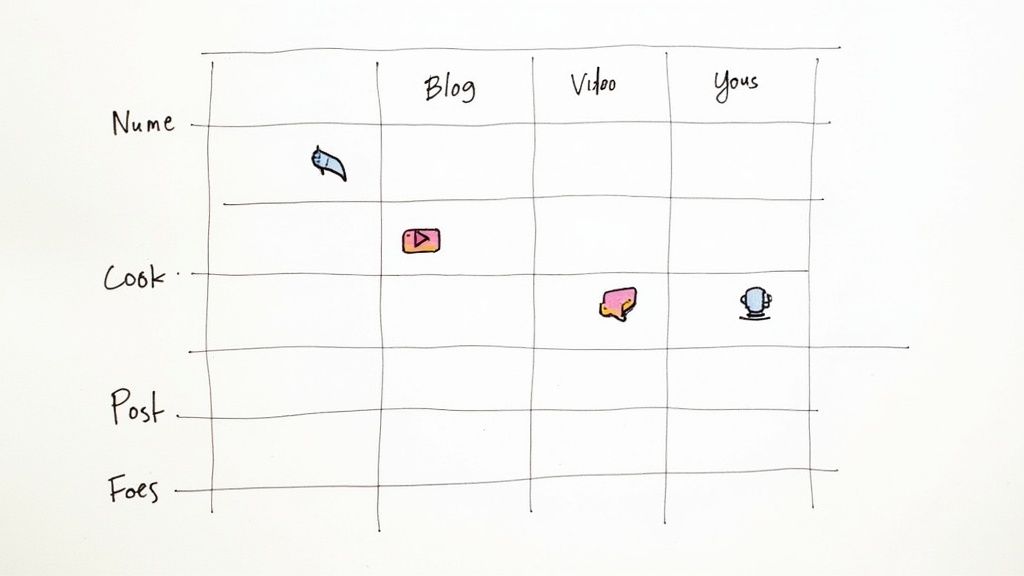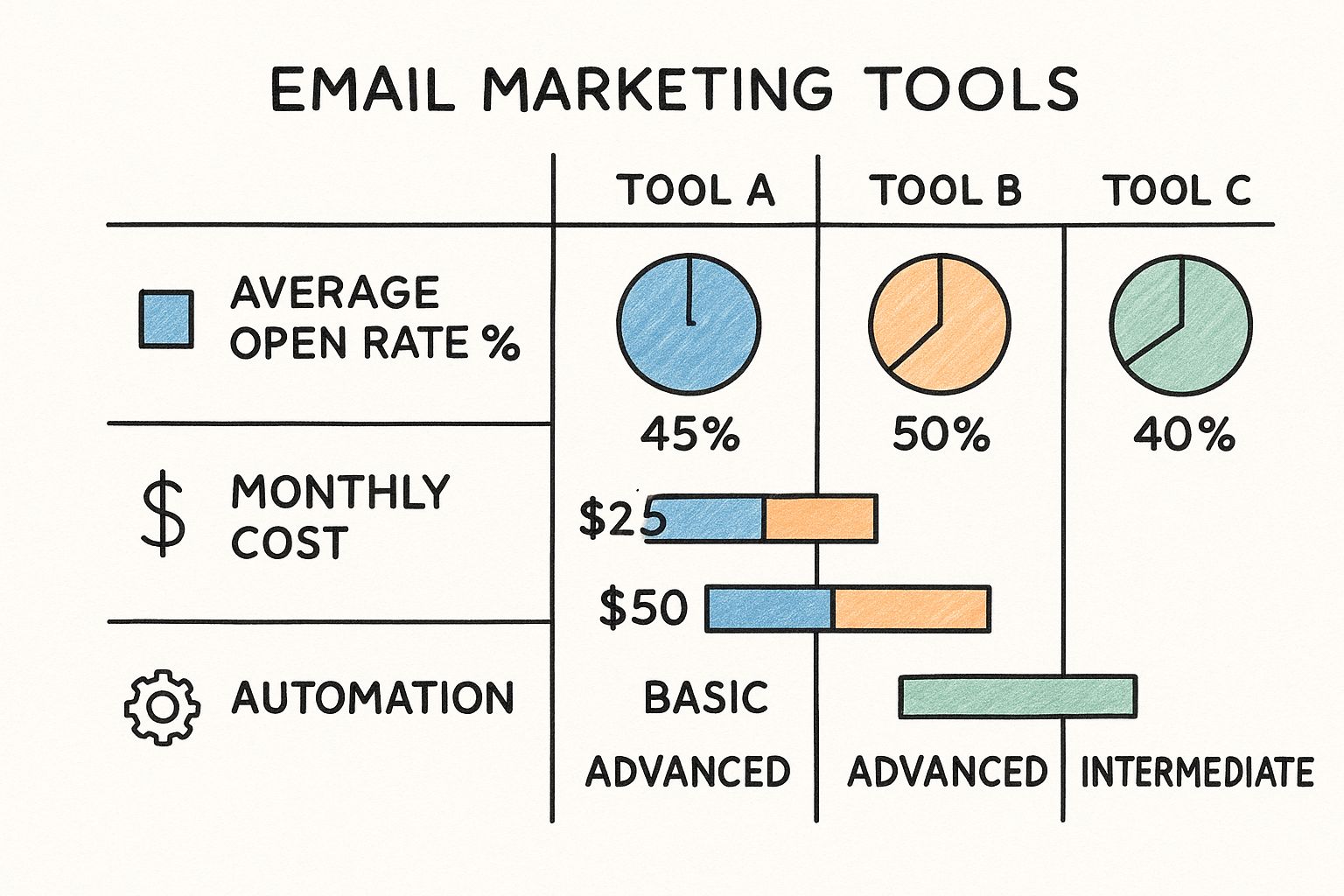How to Build an Author Platform That Sells Books | Easy Guide

So, what exactly is an author platform? Think of it less as a marketing chore and more as building a direct, meaningful connection with your readers. It's the combination of your author website, email list, and social media presence, all working in concert to create a community around you and your work. A strong platform means you have a built-in, enthusiastic audience eagerly waiting for your next book.
Your Foundation: Why an Author Platform is Non-Negotiable

Let's cut right to the chase. In today's publishing world, the single biggest threat to an author's career isn't a bad review—it's obscurity.
Whether you’re gunning for a traditional publishing deal or going the indie route, the old dream of just writing the book and letting the publisher handle the rest is, frankly, a fantasy. Your platform is how you combat obscurity and build a lasting career. It's your personal, direct line to the people who will not only buy your books but become your biggest advocates.
This isn't about spamming "buy my book!" into the social media void. It's about cultivating a real community that's invested in you as a creator and in the worlds you build. It's the foundation of a sustainable career.
Why You Can’t Afford to Skip This
Here's the hard truth: agents and publishers now look at an author's platform as a critical part of their submission package. It’s a direct signal of your marketability. A pre-existing audience dramatically lowers their financial risk. They aren't just buying a manuscript; they're investing in a partner who can help make the book a success.
For self-published authors, the need is even more stark. Without a platform, you’re essentially launching your book to an empty stadium. The competition is fierce, and you need a way to rise above the noise.
The Core Components of a Modern Author Platform
A powerful author platform is more than just one thing; it's an ecosystem where different elements work together. Each piece has a specific job, but their real strength comes from synergy. To get a handle on this, think of it as your own personal content marketing machine; this the ultimate content marketing strategy guide offers a great roadmap for how all the pieces fit together.
To get started, it’s helpful to see what a modern author platform is built on. The following table breaks down the essential pillars and what they do for you.
| Platform Component | Primary Purpose | Key Action |
|---|---|---|
| Author Website | Your professional hub; the one place you completely own and control online. | Create a central location for your bio, book list, blog, and contact info. |
| Email List | The most valuable asset for direct, unfiltered communication with your core fans. | Offer a compelling reason (a "reader magnet") for people to subscribe. |
| Social Media | Your space for daily engagement, community building, and human connection. | Choose 1-2 platforms where your target readers hang out and be consistently present. |
Each of these components plays a vital role in building and nurturing the audience that will sustain your career over the long haul. They are the engine that powers your author business.
A strong author platform gives you control. It transforms you from a writer hoping for a break to an author who creates their own momentum, no matter which publishing path you choose.
Ultimately, building your platform is an investment in your future. It's the steady, consistent work you do between books that ensures each new release lands with an audience ready to welcome it. This isn't an overnight task, but a rewarding process of building trust and connection, one reader at a time.
Defining Your Author Brand and Niche
Before you can even think about building an author platform, you have to pour the foundation. That foundation is your author brand. Let's be clear: your brand isn't some stuffy corporate logo or an online persona you have to put on like a costume. It's the real, recognizable heart of who you are as a writer and what readers can count on getting from you.
Think about your favorite local coffee shop. Its brand is more than just the coffee itself, right? It's the smell when you walk in, the comfy armchairs, the specific playlist they have on repeat, and the baristas who know your order. Your author brand is that same unique atmosphere—the one that makes readers want to pull up a chair and spend time with you and your stories.
Find Your Unique Flavor
So, where does this brand come from? It’s not about inventing a character to play online. It's about finding what’s already compelling about you and turning up the volume. Your most authentic brand sits where three key things overlap.
Your Genre(s): What do you actually write? Whether it’s sweeping epic fantasy, a cozy mystery with a cat sidekick, or hard-hitting nonfiction, your genre sets the initial expectations for your readers. It’s the starting point.
Your Values & Passions: What gets you fired up outside of writing? Maybe you're a fanatic for historical accuracy, a champion for social justice, or someone who finds deep joy in the quiet of rural life. These passions are what make you a person, not just a content machine.
Your Voice & Style: How do you write? Is your prose witty and dripping with sarcasm? Lyrical and poetic? Or are you more direct and analytical? Your writing voice is a huge piece of the puzzle.
When you blend these, something powerful happens. "Sci-fi author" is generic. But a "sci-fi author who explores near-future AI ethics with a dark, humorous tone"? Now that's a brand. It instantly calls out to a very specific kind of reader. To really get this right, it helps to understand how to create a strong personal brand that feels genuine to you and magnetic to your audience.
Who Are You Writing For?
Once you’ve got a handle on your own brand, you need to picture the person on the other end: your ideal reader. Trying to appeal to absolutely everyone is a classic mistake that usually results in connecting with no one.
So, get specific. Don't just settle for "women aged 25-55." That's not a person; it's a demographic. Instead, really imagine your perfect reader. What's their job? What other authors are already on their bookshelf? What podcasts do they listen to on their commute? Where do they hang out online—is it specific Facebook groups, TikTok, or niche forums?
Knowing your ideal reader doesn't shrink your audience; it focuses your marketing. It shows you exactly where to go to find people who are already looking for a writer just like you.
This is more important than ever. The global publishing market is expected to grow by USD 18.9 million between 2025 and 2029, a surge driven in part by indie authors who master this direct-to-reader connection. By carving out your niche, you can grab a slice of that pie. You can explore the full analysis of the publishing market's growth to see what’s driving these trends.
Crafting Your Author Bio
Your author bio is prime real estate. Think of it as a tiny, powerful advertisement for you. It's going to show up everywhere—your website, social media profiles, the back of your book. A great bio does more than just list your degrees or past jobs; it distills the essence of your brand into a couple of memorable sentences.
Here's a simple, effective formula I've seen work time and again:
- State What You Do: Kick it off with your name and what you write. (e.g., "Jane Doe writes historical thrillers...")
- Inject Your Brand: Now, add the special sauce. (...that blend meticulous research with pulse-pounding action.)
- Add a Personal Touch: Drop in a relatable, human detail that clicks with your brand. (When she’s not lost in the archives, she can be found hiking with her rescue dog, Winston.)
See? It's not just a list of facts; it tells a mini-story. This is a foundational step in building your platform. Nailing this from the start is the first real step toward building an author platform that can actually last.
2. Build Your Author Website: Your Digital Hub

Social media trends come and go, and algorithms are a mystery. But your website? That's the one corner of the internet you truly own and control. It's your digital home base—the central hub where readers, agents, and publishers can connect with you and your work. Think of it as the anchor for your entire author brand.
Don't let the tech part scare you off. Putting together a professional, effective author site is more straightforward than you might think. The goal isn't to build a complex, flashy site. It's about creating a clean, welcoming, and functional space for your audience.
Choosing Your Platform and Domain
The first big choice you'll make is the platform you build on. You've got a few solid options, each with its own balance of user-friendliness, cost, and creative freedom.
WordPress: This is the heavyweight champion, powering a massive chunk of the internet. It offers incredible flexibility and can easily grow with your career. You'll find two flavors: WordPress.com (hosted, simpler start) and WordPress.org (self-hosted, total control). For most authors, learning how to start a WordPress blog provides the perfect, robust foundation for their digital home.
Squarespace: Famous for its sleek, modern templates and an intuitive drag-and-drop editor. It’s a fantastic all-in-one solution if you value beautiful design and simplicity above all else.
Wix: Another crowd-pleaser for beginners, Wix gives you a ton of visual control without needing to write a single line of code.
Once you’ve picked a platform, you need a domain name—your website's address. Here's a non-negotiable tip: always use the name you publish under, not a book title. Your author name is the brand that sticks with you for your entire career. If yourname.com is already taken, get creative with variations like yournameauthor.com or yournamebooks.com.
The Essential Pages for Every Author Website
A great author website isn't about having dozens of pages. It’s about having a few essential ones that are well-designed and easy for visitors to navigate. Nail these five, and you’ll have a rock-solid foundation.
1. A Homepage That Makes an Impact You have just a few seconds to make a first impression. Your homepage needs to instantly tell visitors who you are, what you write, and what you want them to do next. Feature your latest book cover front and center, add a short and compelling tagline, and make your navigation menu impossible to miss.
2. A Compelling "About" Page This is where you let readers get to know you. Start with your professional author bio (the 100-300 word version) and a high-quality headshot. But don't stop there. I always recommend adding a more personal, first-person section to share your story and personality. It’s what makes you relatable.
3. A "Books" Page That Sells This is arguably the most important page on your entire site. You need a dedicated page for each book or series. For every title, be sure to include:
- The high-resolution cover image.
- A short, punchy description that hooks the reader.
- Praise or blurbs from other authors or key reviews.
- Clear "Buy Now" buttons linking to major retailers (Amazon, Barnes & Noble, Bookshop.org, etc.).
Pro Tip: Make buying your book effortless. Don't just send readers to a generic Amazon homepage. Provide direct links for each book on multiple platforms so they can buy from their favorite retailer without having to search.
4. A Blog to Build Your Community Your blog is what gives people a reason to come back again and again. It’s your tool for building a community and sharing your unique voice. You can write about your research rabbit holes, explore a theme from your novel, or offer writing advice. Plus, consistent blogging does wonders for your site's SEO.
5. A Contact Page and Email Signup Form Make it dead simple for people to reach out. A contact form is usually better than just listing your email address, as it helps cut down on spam.
Most importantly, you need to feature an email newsletter signup form everywhere. Place it in your website's header or footer, at the end of every blog post, and even on its own page. Your email list is the single most valuable asset you have as an author, and your website is the number one tool for growing it.
Creating Content That Connects with Readers
So, you’ve built your website and defined your brand. What’s next? What’s going to keep readers interested and coming back between your book launches? The answer, plain and simple, is content.
Think of your content as the engine of your author platform. It’s the steady pulse that builds trust, shows off what you know, and gathers a community of people who are genuinely excited about your work. This isn't about just churning out generic articles. It's about building a content plan you can actually stick with—one that feels like you and gives your ideal readers something of real value. Your blog is the perfect place to make this happen.
Brainstorming Ideas That Resonate
Staring at a blank page for a blog post can feel just as daunting as Chapter One of a new novel. The trick is to stop thinking like a marketer and start thinking like your reader. What makes them tick? What are they curious about? What connects them to your genre and your stories in the first place?
The good news is that the best ideas are probably hiding in plain sight, woven right into your books and your life as a writer.
- Explore Your Book's Themes: Does your novel dive into betrayal and forgiveness? Write a post about the most famous betrayals in history or literature. You'll naturally attract people already fascinated by the core ideas in your work.
- Share Your Research Rabbit Holes: Remember spending three weeks learning about 18th-century naval medicine for a single scene? Share the most fascinating, bizarre, or gruesome facts you dug up. Readers absolutely love these behind-the-scenes peeks.
- Discuss Your Writing Process: Show people how you outline a mystery, build a fantasy world's magic system, or finally wrestle writer's block into submission. This is a great way to connect with fellow writers and aspiring authors, building a different but valuable part of your community.
- Analyze Your Genre: Talk about the tropes you love (or love to break). If you write romance, you could dissect the "enemies to lovers" dynamic. If you write thrillers, you could analyze what makes a plot twist truly shocking.
By focusing on topics that genuinely excite you and are related to your books, you create content that not only pulls in the right audience but also deepens their appreciation for what you do. It’s a win-win.
Writing Posts That People Actually Read
Once you have a great idea, the goal is to make it impossible to click away from. A blog post is not a manuscript. People browsing online have short attention spans, so your writing needs to be direct, easy to scan, and full of value.
Always start with a compelling headline that promises a clear benefit. Instead of "My Writing Process," try something like, "5 Unconventional Tricks I Use to Beat Writer's Block." It’s specific and promises a real solution.
Inside the post, use short paragraphs, bullet points, and subheadings to break up the text. Nobody wants to be confronted by a wall of text. It's also a good idea to sprinkle in keywords your readers might be searching for, like "best fantasy world-building tips" or "how to write a compelling villain."
Maximize Your Impact by Repurposing Content
Let's be real: creating great content takes time. You need to make every single piece work as hard as possible for you. This is where smart repurposing becomes your best friend. One well-researched blog post can easily fuel a whole week's worth of content across your entire platform.
Here’s how you could slice and dice one blog post:
- The Core Blog Post: "The Hidden History Behind My New Noir Thriller"
- Email Newsletter: Share a short, intriguing snippet from the post, then link back to your website for the full story.
- Instagram Post: Find a cool vintage photo related to your research and use a fascinating fact from your blog post as the caption.
- Twitter Thread: Break down five key takeaways from the post into a numbered, easy-to-digest thread.
- Facebook Post: Spark a conversation by asking your followers a question related to the blog post's theme.
This strategy doesn't just save you a ton of time; it keeps your message consistent everywhere you show up online. It’s a cornerstone of building an author platform without burning out. As you get more established, this can even open up new ways to make money. Rates for blog entries can range from $50 to over $300 per post. You can discover more about the potential of freelance writing opportunities that a strong platform unlocks. Ultimately, consistency is the secret ingredient that turns casual visitors into your most loyal fans.
4. Connecting with Readers Through Social Media and Email
With your author website up and running and a steady stream of content flowing, it’s time to open up direct lines of communication. Think of social media and email as your personal channels for building real relationships with readers, turning them from casual followers into a genuine community that’s excited for your next book.
It’s tempting to jump on every social media platform at once, but that's a classic recipe for burnout. The real goal isn’t to be everywhere; it's to be where your ideal readers already are.
Choosing Your Digital Hangout
Let your brand and your reader guide this decision. Don't just pick a platform because it's trending—go where you can have authentic conversations.
For instance, if you write Young Adult fantasy, you'll probably find your audience on visually-driven platforms like TikTok and Instagram. On the other hand, if your niche is business non-fiction or historical thrillers, you might find a more engaged community on Facebook or even LinkedIn.
To get a deeper understanding of which platform fits your genre, our in-depth guide to social media for authors is a great resource.
Expert Tip: Your social media presence shouldn't be a constant sales pitch. Treat it like your digital living room. Share behind-the-scenes glimpses of your writing life, talk about books you love in your genre, and let the human side of your author brand shine through. That's how you build trust.
Choosing the right platform is the first critical step. To help you decide where to invest your time, here’s a breakdown of the most popular options for authors.
Choosing the Right Social Media Platform for Authors
| Platform | Best For Authors Of | Content Focus | Primary Audience |
|---|---|---|---|
| YA, Fantasy, Romance, Lifestyle Non-Fiction | High-quality visuals, short videos (Reels), cover reveals, personal updates | Millennials & Gen Z | |
| TikTok | YA, Fantasy, Sci-Fi, Romance | Short, creative videos, book recommendations (#BookTok), trends | Primarily Gen Z |
| Thrillers, Mysteries, Historical Fiction, Non-Fiction | Community building (Groups), longer posts, live video, event promotion | Gen X & Millennials | |
| X (Twitter) | Sci-Fi, Fantasy, Literary Fiction, Journalism | Quick updates, industry conversations, engaging with other writers/agents | Broad, but strong in literary and media circles |
| Cookbooks, DIY, Design, Fantasy/Historical (inspiration boards) | Visual discovery, infographics, character aesthetics, world-building | Predominantly female, across various age groups |
Ultimately, the best platform is the one you genuinely enjoy using. Authenticity can't be faked, and your readers will notice.
Your Most Powerful Asset: The Email List
While social media is fantastic for discovery and daily interaction, your email list is hands-down your most valuable marketing asset. It's the only communication channel you truly own, free from the whims of algorithms.
A follower on Instagram belongs to Instagram. An email subscriber belongs to you.
First, you'll need to pick an email marketing service. There are several excellent choices out there, each with its own vibe.
- Mailchimp: A lot of authors start here. It's known for being incredibly user-friendly and has a great free plan for those just getting their feet wet.
- ConvertKit: This one was built specifically for creators. It has powerful automation and tagging features that are perfect for sending targeted content as your list grows.
- MailerLite: A powerful contender that mixes an easy-to-use interface with advanced features, often at a better price than its competitors.
This visual breakdown compares some key aspects of popular email services to help you decide.

As you can see, the core tools are solid across the board. Your choice will likely come down to your budget and which interface feels most intuitive to you.
Growing Your List with an Irresistible Offer
Let’s be honest—people are protective of their inboxes. A simple "sign up for updates" just doesn't cut it anymore. To get someone to subscribe, you need to offer something valuable in return. In the marketing world, we call this a lead magnet, but for authors, it’s a reader magnet.
Your reader magnet should be something your target reader actually wants and is directly tied to your books.
A Few Reader Magnet Ideas to Get You Started:
- A free short story or a prequel set in your book’s universe.
- For non-fiction, a helpful checklist or guide related to your topic.
- The first 3 chapters of your most popular or upcoming book.
- Exclusive goodies like character art, world maps, or a "deleted scenes" PDF.
Once you’ve created your reader magnet, feature it everywhere—on your website's homepage, in the footer, at the end of every blog post, and in your social media bio. Make it easy for people to say "yes!"
Crafting Newsletters People Actually Want to Open
With your list starting to grow, the last piece is figuring out what to send. Remember this: consistency is more important than frequency. A thoughtful monthly newsletter is far better than a frantic, salesy email you only send when you have a new release.
Your newsletter is not just an ad. Aim for the 80/20 rule: 80% value and connection, 20% promotion. Share a personal story about your writing process, recommend a few books you recently loved, or give an exclusive sneak peek of a scene you're working on.
Treat your email subscribers like insiders in a private club. When you do, you build an army of fans who will not only rush to buy your books but will become the champions who help you build a career that lasts.
Common Author Platform Questions Answered

When you first start thinking about building an author platform, it can feel overwhelming. I get it. You're a writer, not a marketer, and the path ahead is filled with questions. Let's cut through the noise and tackle some of the most common worries I hear from authors just starting out.
These aren't abstract theories. These are direct, no-nonsense answers drawn from experience, designed to give you the clarity and confidence to just get started.
How Much Time Does This Realistically Take?
This is the million-dollar question, isn't it? The honest answer is that building a platform is a marathon, not a sprint. There's no magic number of hours, but a good rule of thumb is to set aside 3-5 hours per week. This isn't a second job, but it does require consistent, focused effort.
I often tell authors to think of it like tending a garden. You can’t just scatter some seeds and hope for the best. It needs regular attention. The initial setup—getting your website live and creating social profiles—will take a bit more time upfront. But once you establish a rhythm, consistency is what truly fuels growth.
So, what does that look like in practice? A typical week might break down like this:
- 1-2 hours: Writing and scheduling one new blog post.
- 1-2 hours: Creating and scheduling your social media posts for the week.
- 30-60 minutes: Actually engaging with readers, followers, and other authors online.
The real secret is to start small and stay consistent. It's far better to publish one great blog post a month and be active on a single social media channel than to try doing everything at once and burning out. Your platform grows from that steady, cumulative effort.
Do I Need a Platform Before My Book Is Out?
Yes. One hundred percent, yes. Waiting until your book is about to launch is one of the biggest and most common mistakes an author can make. You simply cannot build an audience of eager readers overnight. It takes time—often years—to earn that trust and attention.
Starting early lets you build genuine connections and a sense of anticipation. When you finally announce your book, you won't be shouting into an empty room. You’ll be sharing your exciting news with a community that already knows you and is invested in your work.
This pre-launch phase is also the perfect time to test the waters and learn invaluable lessons about how to market a book by seeing what kind of content truly connects with your future readers.
What Does Success Look Like Beyond Follower Counts?
It's so easy to get fixated on vanity metrics like follower counts. While those big numbers can feel good, they don't tell the whole story. Real success is measured by engagement, not just reach.
Believe me, a small, highly engaged audience is infinitely more valuable than a massive, silent one.
Here are the metrics that actually matter:
- Email List Growth: Are you steadily adding new, dedicated subscribers each month?
- Email Open & Click Rates: Are people actually opening your newsletters and clicking your links?
- Meaningful Comments & DMs: Are you sparking genuine conversations?
- Website Traffic: Are your efforts on social media and email successfully driving people back to your website?
Success is when a reader replies to your newsletter to share a personal story. It's when a comment on your blog post sparks a thoughtful debate. It's having that small but mighty group of fans who are genuinely excited for whatever you create next. That's the real power of an author platform.
Ready to turn your manuscript into a marketing powerhouse? ManuscriptReport.com creates comprehensive book reports, social media content, and blog series in minutes, giving you all the assets you need to build your platform and sell more books. Get your complete marketing kit today.
Related Articles

7 Essential Steps for an Affordable Book Launch
Discover 7 steps to launch your book affordably. Perfect for self-published authors.

How to Write Viral Book Hooks: 10 Proven Strategies for Social Media Success
Master the art of viral book hooks with 10 proven strategies, platform-specific tactics, and templates that grab attention on BookTok, Instagram, and beyond.

7 Must-Have AI Writing Tools for Authors
Discover essential AI writing tools for authors to boost creativity and streamline marketing. Learn actionable tips and explore solutions like ManuscriptReport.com.